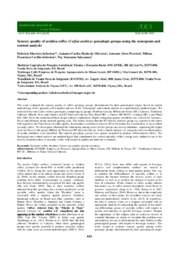Sensory quality of arabica coffee (Coffea arabica) genealogie groups the sensogram and content analysis.
Sensory quality of arabica coffee (Coffea arabica) genealogie groups the sensogram and content analysis.
Author(s): SOBREIRA, F. M.; OLIVEIRA, A. C. B. de; PEREIRA, A. A.; SOBREIRA, M. F. C.; SAKYIAMA, N. S.
Summary: This work evaluated the sensory quality of coffee genotype groups , discriminated by their genealogical origin, based on current methodology of the specialty coffee market and use of the "Sensogram" and content analysis as complementary methodologies. We assessed forty-one Coffea arabicagenotypes, comprising six groups: Bourbon, Caturra, Híbrido de Timor (HT), Catimor, Traditional Cultivars (Mundo Novo and Catuaí), and HT Derived Cultivars (Pau-Brasil MG 1, Paraíso MG H419 -1, Catiguá MG 2 and Obatã IAC 1669-20) in the randomized block design with two replications. Higher intragroup genetic variability was verified for sweetness, flavor and aftertaste on the standard grading scale. The results showed that the HT derived cultivars group was superior to the others with regards to the Final Score of coffee quality. It presented a confidence interval (85 to 89 points) for classification as an excellent specialty coffee . The Sensogram illustrated the relationship among scores for the groups and sensory attributes, expressing the higher score for flavor in the groups Híbrido de Timor and HT derived cultivars. In the content analysis, six categories and ten subcategories of quality attributes were identified. The studied genealogic groups have genetic potential to produce differentiated coffees. The Sensogram and content analysis are methodologies that complement the current specialty coffee scoring scale, subject to use in the sensory characterization of specialty coffee with respect to quality and intensity of nuances.
Publication year: 2015
Types of publication: Journal article
Unit: Embrapa Coffee
Keywords: Bourbon, Coffea arabica, Cup quality, Flavor, Specialty coffee, genetic resources
Observation
Some of Embrapa's publications are published as ePub files. To read them, use or download one of the following free software options to your computer or mobile device. Android: Google Play Books; IOS: iBooks; Windows and Linux: Calibre.
Access other publications
Access the Agricultural Research Database (BDPA) to consult Embrapa's full library collection and records.
Visit Embrapa Bookstore to purchase books and other publications sold by Embrapa.

